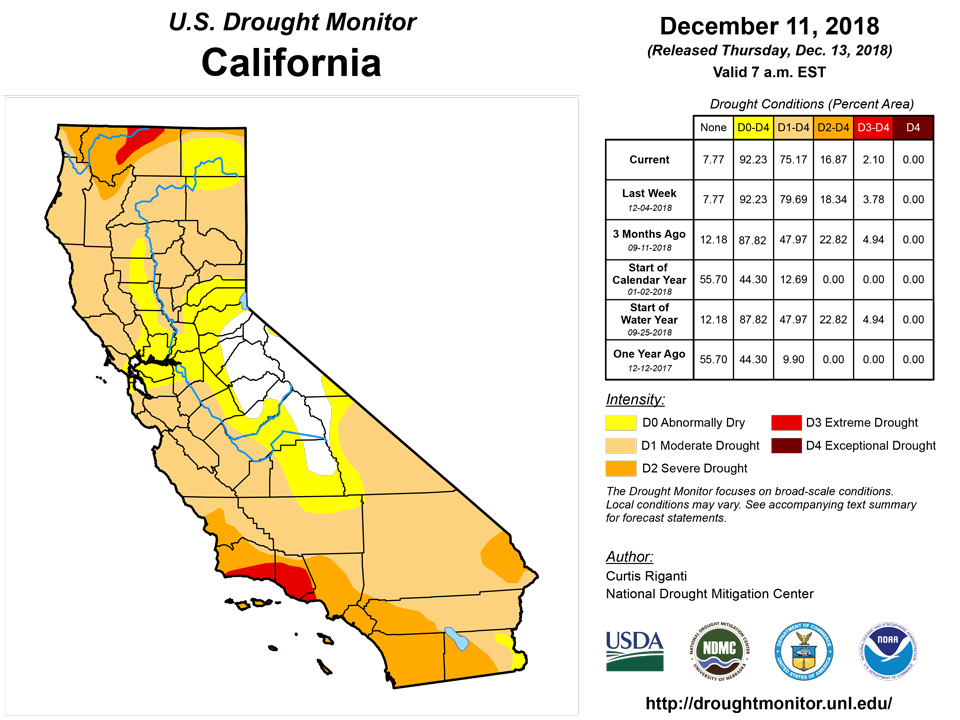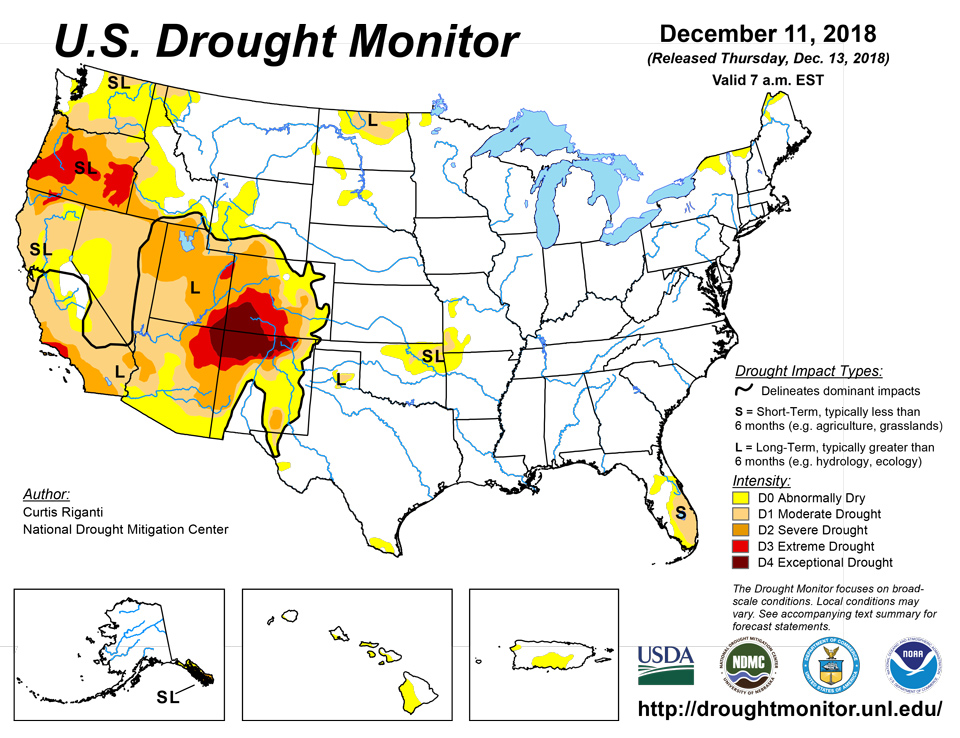
California and National Drought Summary for December 11, 2018
Summary
December 13, 2018 - Over the past week, moderate to heavy precipitation fell over much of the southern tier of the United States. The highest amounts occurred from eastern Texas through the Carolinas, and relatively high amounts also fell in southern California and southwestern Arizona. Elsewhere, precipitation also fell in the Coastal Ranges from northern California to the Canadian border. Cooler than normal weather occurred over most of the United States east of the Continental Divide, while warmer conditions were found in parts of California, Arizona, and southeastern New Mexico. Improvements in drought conditions occurred in the Mojave Desert regions of California and Arizona, from San Francisco Bay into the Central Valley. Drought developed or worsened in central Nevada, northwestern Oregon, from northeastern Oklahoma into southwestern Missouri, and in the Florida Peninsula.
Northeast
Over the last week, only a few areas of light precipitation occurred in the Northeast as the strong storm system that traversed the southern United States remained mostly to the south. Given the dry and cooler than normal conditions this week in the Northeast, abnormally dry long-term conditions remained in northern New England, and no changes were made to the drought depiction in the Northeast.
Southeast
Heavy rain and snow fell this week as a strong storm system moved into the region from the southern Plains. Most areas outside of the southern Florida Peninsula and far northern Virginia received moderate or heavy rain. Heavy snow also fell in western parts of the Carolinas. Since the precipitation this week lessened short-term deficits, remaining areas of abnormal dryness along the northern Florida coast, Georgia coast, and South Carolina coast were removed. In the southern Florida Peninsula, moderate drought was expanded as short-term precipitation deficits continued to build and streamflow and surface water conditions worsened.
South
Moderate to heavy precipitation took place this week from western Texas through southern Oklahoma and central and southern Arkansas, into the Southeast. Slight improvements were made in southwestern Texas, where recent heavy rain was enough to lessen the extent of abnormally dry conditions since short-term precipitation deficits improved here. North of where the precipitation fell, abnormally dry conditions and moderate drought were expanded in north-central and northeastern Oklahoma. Elsewhere, given the widespread precipitation that fell, no changes were made to the drought depiction.
Midwest
Weather this week in the Midwest was mostly dry and cool. Some precipitation fell in southeastern Kentucky, but precipitation was quite sparse elsewhere. The only changes to this week’s drought depiction were an expansion of moderate drought into southwestern Missouri and a slight expansion of abnormally dry conditions in southwestern Missouri. These degradations were made where short- and long-term precipitation deficits had grown and surface and groundwater conditions were poor. Elsewhere, the drought depiction remained the same as last week, with only a few other areas experiencing abnormally dry conditions.
High Plains
Weather across the High Plains this week was generally dry, with cooler weather taking place in Nebraska and Kansas, and more variable temperatures occurring in the Dakotas and in the high plains sections of Colorado, Wyoming, and Montana. Abnormally dry conditions improved in north-central Montana, as long-term precipitation deficits had lessened such that conditions were no longer abnormally dry. Elsewhere, the drought depiction was unchanged.
West
Moderate to heavy precipitation fell in the Mojave Desert region of California and Arizona, giving some of these areas 10-25% of their annual precipitation. This lessened long-term deficits in southeastern California and parts of southwestern Arizona, leading to widespread one-category improvements. Moderate drought also was removed from the San Francisco Bay to the Central Valley area, where short- and long-term precipitation deficits had been reduced enough to bring them out of moderate drought. Despite some recent precipitation in northwestern Oregon, short- and long-term precipitation deficits were large enough and surface and groundwater shortages severe enough to expand the footprint of extreme drought in this area. In central Nevada, moderate drought was introduced where precipitation deficits grew on multiple time scales and streamflow conditions worsened. Abnormally dry conditions expanded through parts of the mountains of central Idaho and in mountainous regions of northwestern Montana, where low snowpack existed and short-term precipitation deficits grew.
Alaska, Hawaii, and Puerto Rico
No changes were made to the drought depiction in these areas this week. Short-term dryness and scattered low streamflow continued in southern and northwestern Puerto Rico, where abnormally dry conditions persisted. Abnormally dry conditions also continued on the westward-facing slopes of the Hawaiian Islands. Severe drought, moderate drought, and abnormally dry conditions also persisted in southeast Alaska.
Looking Ahead
Next week, a strong storm system is forecast to develop over the southern Plains and move eastward across the United States. Moderate to heavy rain, perhaps mixed with some snow, is forecast in north Texas, and this precipitation is expected to move eastward to the southeastern U.S. coast. Windy conditions are likely in the southern Plains on Thursday and Friday as this storm system moves across the region, which may lead to increased evaporative demand in the region. Generally warmer than normal conditions are also forecast in much of the continental U.S., though short periods of cooler than normal weather may occur from Texas eastward to the Atlantic Coast.
Author(s):
Curtis Riganti, National Drought Mitigation Center
Dryness Categories
D0 Abnormally Dry—used for areas showing dryness but not yet in drought, or for areas recovering from drought.
Drought Intensity Categories
D1 Moderate Drought
D2 Severe Drought
D3 Extreme Drought
D4 Exceptional Drought
Drought or Dryness Types
S Short-Term, typically less than 6 months (e.g. agricultural, grasslands)
L Long-Term, typically greater than 6 months (e.g. hydrologic, ecologic)
Source: National Drought Mitigation Center









